With the advancement of the new four modernizations (electrification, intelligence, connectivity, and sharing) in the automotive travel field, various automobile manufacturers are gradually building Internet of Vehicles (IoV) systems centered on smart driving and smart connectivity.
The new generation of IoV systems places higher demands on the architecture of underlying message collection, transmission, and processing platforms.
The MQTT protocol is currently the most suitable communication protocol for building data platforms in IoV scenarios.
Based on this, we will continue to discuss MQTT message collection and transmission in IoV scenarios, as well as how to build a messaging platform capable of supporting millions of connected vehicles, with the aim of providing platform architecture design references for enterprises engaged in IoV business.
The Foundation of IoV: Data Collection and Transmission
The Evolution of IoV Transmission Protocols
As we all know, the Internet of Vehicles (vehicle-to-everything, V2X) refers to a dynamic mobile communication system that enables interactions between vehicles and the cloud, vehicles and the network, vehicles and other vehicles, vehicles and roads, vehicles and people, and vehicles and sensing devices, achieving communication with public networks to meet the efficiency, safety, and management elements in every aspect related to vehicles. The communication protocols operating within this system become the key and core to the construction of IoV systems.
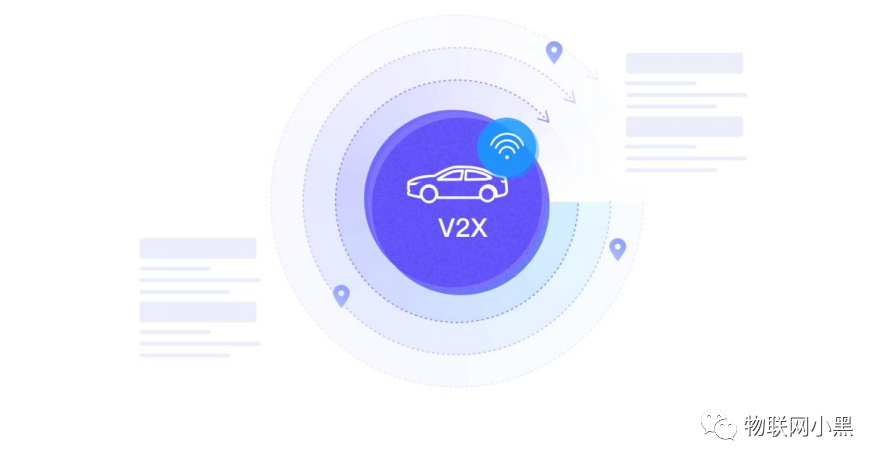 Throughout the development of IoV, there have been two mainstream communication technologies that have played a significant role in driving the overall development of IoV:
Throughout the development of IoV, there have been two mainstream communication technologies that have played a significant role in driving the overall development of IoV:
1. DSRC (Dedicated Short Range Communications): Developed in 1992 by the American Society for Testing and Materials (ASTM) for the ETC business scenario, it has evolved into the IEEE (802.1X) IoV communication technology standard after years of refinement and iteration. For a considerable period, DSRC technology was the mainstream IoV communication protocol used in the international automotive production and consumption markets.
2. C-V2X (Cellular Vehicle-to-Everything): C-V2X relies on existing cellular base stations and supports direct PC5 communication. RSUs and vehicles can connect to the V2X platform through 4G/5G channels (using the Uu interface), achieving vehicle-road cooperative communication. Compared to DSRC, C-V2X is technically superior, enhancing communication security and confidentiality, supporting high network capacity, and accommodating high bandwidth and large data volume requirements.
The competition between DSRC and C-V2X technologies is intense, with both vying to become the mainstream IoV communication standard. Currently, China has the most comprehensive 5G communication network infrastructure, thus leaning towards adopting C-V2X (LTE-V, 5G-V2X) communication technology to achieve a new generation of IoV architecture based on automated driving through the systematic construction of V2X vehicle-road systems and intelligent vehicle systems.
The Significance of Messaging Platform Construction for IoV
In the rapidly developing landscape of IoV, all manufacturers have reached a consensus: the purpose of building IoV is not merely to connect for the sake of connectivity, nor is it for in-car entertainment; connectivity is for data. With IoV, data is generated. With data, supported by a complete data governance and application system, everything is possible. Moreover, this business target data is not limited to vehicle-related data alone. Within the V2X framework, interconnectivity between vehicles (V2V), vehicles and roads (V2R), vehicles and networks (V2I), vehicles and clouds (V2C), and vehicles and people (V2H) must be addressed, achieving comprehensive data collection and analysis for vehicles, roads, clouds, networks, and people. Based on the 5G C-V2X protocol and communication methods, foundational capabilities are provided for the construction of the entire system.
From traditional OTA applications to intelligent cockpit adaptations, centimeter-level positioning, long connections for vehicle systems, mobile message collection, vehicle-road-cloud mapping, cooperative vehicle-road systems, and various new intelligent application scenarios, the demand for messaging platforms and data processing systems in IoV has expanded from the original vehicle-cloud model to an integrated architecture of people-vehicles-roads-networks-cloud, thus raising higher requirements for the overall construction of messaging platforms.
How to build a messaging communication and transmission system architecture capable of massive connections, high concurrency throughput, and low latency to ensure the entire system’s ubiquity, convenience, high availability, reliability, security, and high concurrency has become the key to the construction of a new generation of IoV systems based on automated driving and vehicle-road collaboration.
Design of the IoV Messaging Platform Architecture
Next, we will take EMQ’s IoV messaging platform and data processing overall solution as an example to illustrate how to construct a messaging platform capable of supporting millions of connected vehicles.
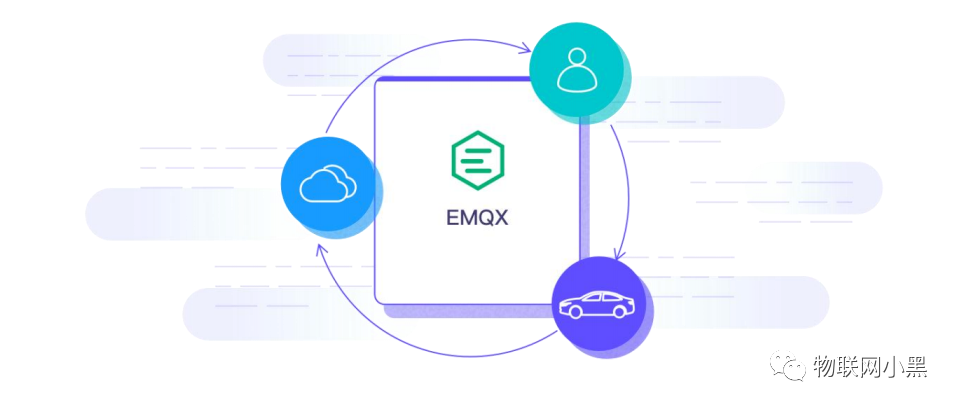
Business Challenges
• Secure Access for Vehicle Systems, Road Test Units, and Mobile Systems
The vehicle side needs to encompass new vehicle-linked services such as vehicle data reporting, POI distribution, file pushing, configuration distribution, message pushing, and operational care, generating a massive number of messages. The Topics generated require safer and more stable access and transmission for message subscription and publishing. The road side needs to achieve secure access for road test RSUs, message collection and transmission, and map data transmission.
• Real-time and Reliability of High Concurrency Message Delivery
High-precision maps, centimeter-level positioning, and vehicle-road collaboration applications all require the capability to ensure millisecond-level low latency and high reliability for the massive vehicle-road map messages, necessitating that the messaging processing platform possesses high performance, low latency, and high reliability to support millions of connections and hundreds of thousands of concurrent business scenarios.
• Integration of Rich Application Scenarios
In an IoV system centered on automated driving, the messaging platform needs to interface with various applications related to people, roads, maps, and clouds. Vehicle data must be connected through the messaging platform with high-precision maps, centimeter-level positioning, vehicle-road collaboration, mobile connectivity, and other application scenarios to ensure the supply of application consumption while providing a high-performance, low-latency, and high-reliability data architecture.
• Massive Data Storage, Processing, and Distribution
Massive IoT data collected from people, vehicles, roads, clouds, maps, and networks must undergo full lifecycle management for access, storage, processing, and distribution of these large-scale real-time data streams, providing database support for applications to deeply utilize IoV data to serve consumers and make business decisions.
Overall Solution
In this solution, we mainly adopt EMQ’s cloud-native distributed IoT access platform, EMQX, to realize data connection, mobility, and processing between the vehicle side and people, road sides within the IoV system. EMQX’s integrated distributed MQTT messaging service and powerful IoT rules engine can provide foundational capabilities for high-reliability, high-performance real-time data mobility, processing, and integration, assisting enterprises in quickly building critical business IoT platforms and applications.
• Message Processing for the Vehicle Side
EMQX connects to the vehicle system using the MQTT protocol. The vehicle system connects to the EMQX distributed cluster through load balancing. EMQX’s horizontal scaling capability enables data communication capabilities for millions of vehicle connections and hundreds of thousands of concurrent responses. Through the rules engine, it can achieve one-stop capabilities for massive message bridging, message queue persistence, offline message storage, etc., while providing rich API atomic capabilities for northbound integration.
In terms of security, EMQX not only supports TLS/DTLS or national secret GMSSL security protocols to ensure system reliability and stability;
but also provides multiple guarantee mechanisms such as heartbeat monitoring, will messages, and QoS levels, achieving real-time, secure, and reliable vehicle messaging communication in complex network environments through offline message storage.
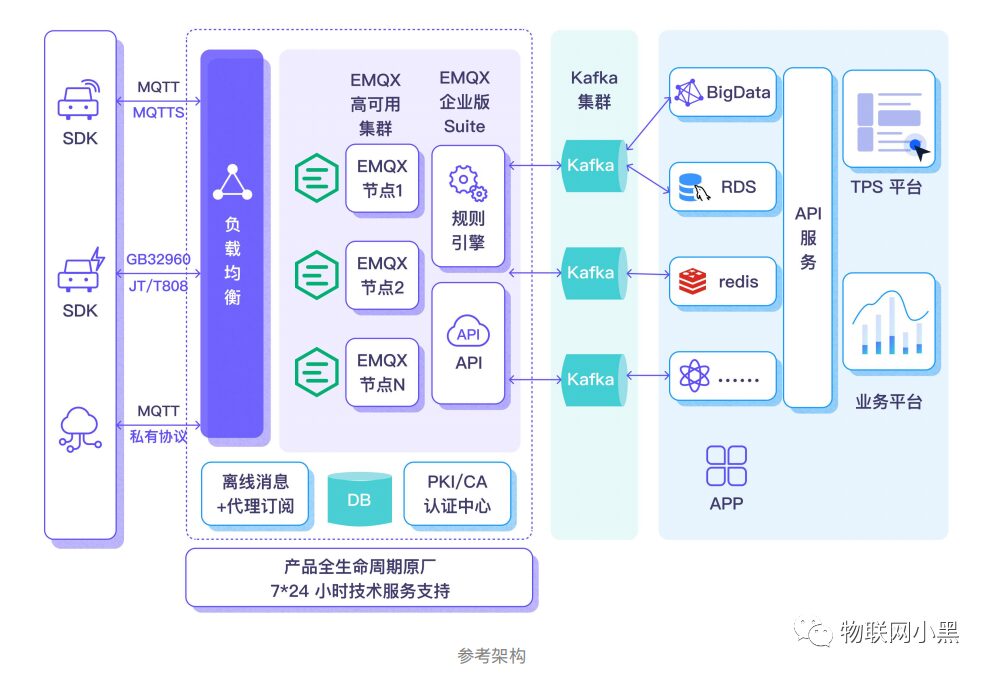
• Message Processing for People and Road Sides
EMQX provides a message collection and processing platform for people and road sides, such as mobile apps and RSUs. Based on the slicing capability of the 5G network, ultra-low latency traffic information services are achieved through proximity access of personal terminals and roadside units. Through protocols like MQTT, road condition information perceived by people and roadside facilities is pushed to the cloud control platform, where V2X algorithms are integrated to achieve intelligent traffic scenarios such as road collaborative perception, safety reminders, and remote collaborative control.
In terms of security, it supports internationally standardized TLS/DTLS encryption or national secret algorithm GMSSL encryption, ensuring secure communication for the collaboration of people, vehicles, and road information systems through an extended PKI/CA certificate authentication system.
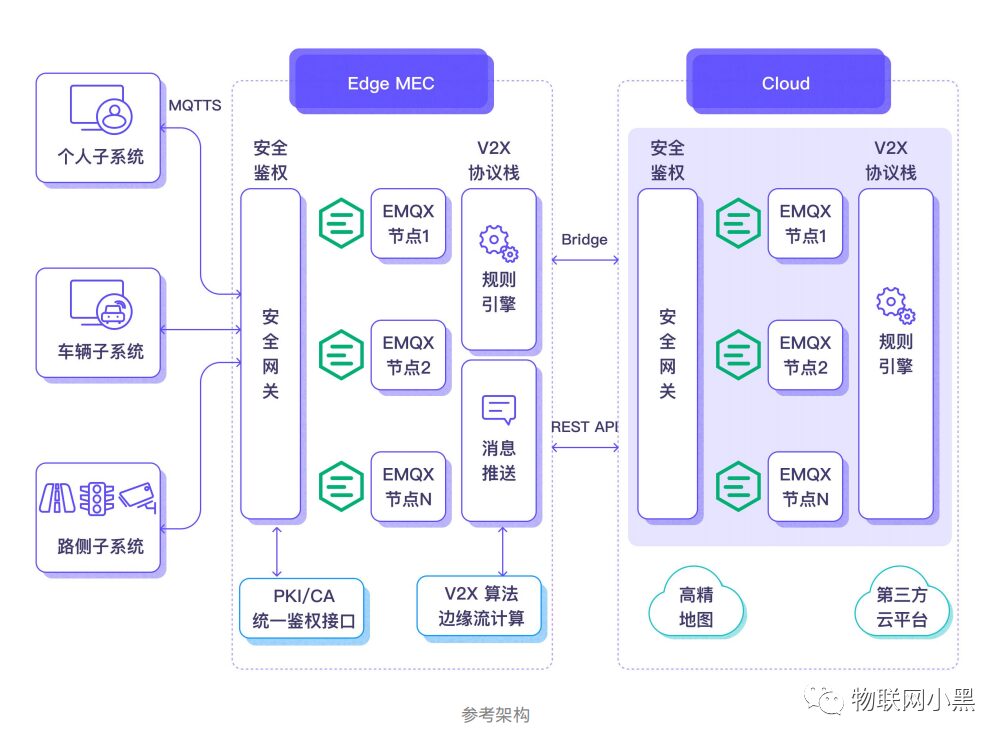
Framework Model for Millions of Messages Access
For the new generation of IoV scenarios, EMQ provides an overall messaging access and data processing platform capable of supporting millions of connections and hundreds of thousands of concurrent connections.
The reference architecture is as follows:
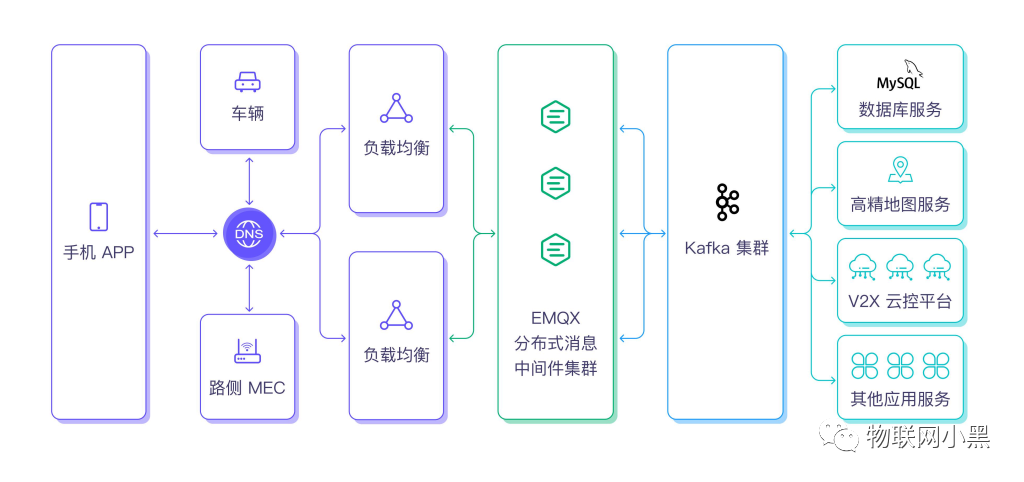
Business Scenario: In the IoV system, vehicles, mobile apps, roadside RSUs, and other devices connect through MQTT, achieving concurrent access capability for millions of terminals.
System Architecture: Terminal devices connect through protocols such as MQTT and HTTP, connecting through load balancing components to the distributed messaging platform EMQX. Through distributed multi-cluster deployment, it meets the demand for millions of concurrent connections, with a throughput capacity of hundreds of thousands of messages, and integrates with Kafka clusters through the rules engine to realize data forwarding. The IoV service platform, high-precision map services, V2X cloud control services, positioning services, and other vehicle network-related applications can directly consume data by subscribing to Kafka data, while EMQ provides three southbound interface services: REST, MQTT, and MQ messaging queues to achieve bidirectional communication for vehicle control (remote control) messages.
Through the above reference framework, EMQ, with the EMQX cloud-native distributed IoT access platform, can meet the business needs of millions of connections and hundreds of thousands of concurrent connections in IoV scenarios.
This article is sourced from the “Architecture Design of MQTT Messaging Platform for Millions of Connected Vehicles” white paper.
Follow our public account and reply “IoV” to obtain more information.